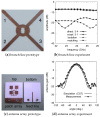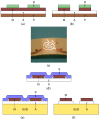A 24-GHz Front-End Integrated on a Multilayer Cellulose-Based Substrate for Doppler Radar Sensors
- PMID: 28895914
- PMCID: PMC5621086
- DOI: 10.3390/s17092090
A 24-GHz Front-End Integrated on a Multilayer Cellulose-Based Substrate for Doppler Radar Sensors
Abstract
This paper presents a miniaturized Doppler radar that can be used as a motion sensor for low-cost Internet of things (IoT) applications. For the first time, a radar front-end and its antenna are integrated on a multilayer cellulose-based substrate, built-up by alternating paper, glue and metal layers. The circuit exploits a distributed microstrip structure that is realized using a copper adhesive laminate, so as to obtain a low-loss conductor. The radar operates at 24 GHz and transmits 5 mW of power. The antenna has a gain of 7.4 dBi and features a half power beam-width of 48 degrees. The sensor, that is just the size of a stamp, is able to detect the movement of a walking person up to 10 m in distance, while a minimum speed of 50 mm/s up to 3 m is clearly measured. Beyond this specific result, the present paper demonstrates that the attractive features of cellulose, including ultra-low cost and eco-friendliness (i.e., recyclability and biodegradability), can even be exploited for the realization of future high-frequency hardware. This opens opens the door to the implementation on cellulose of devices and systems which make up the "sensing layer" at the base of the IoT ecosystem.
Keywords: Doppler radar sensors; Internet of things (IoT); all-natural electronic; circuits on cellulose; flexible substrates; green electronics; paper-based substrates; substrate integrated circuits.
Conflict of interest statement
The authors declare no conflict of interest.
Figures









References
-
- Manyika J., Chui M., Bughin J., Dobbs R., Bisson P., Marrs A. How the Internet of Things is More Like the Industrial Revolution than the Digital Revolution. McKinsey & Company; New York, NY, USA: 2013. MGI Report.
-
- Evans D. The Internet of Things: How the Next Evolution of the Internet is Changing Everything. Cisco Systems; San Francisco, CA, USA: 2011. CISCO White Papers.
-
- Savage N. All-natural electronics. IEEE Spectr. 2015;52 doi: 10.1109/MSPEC.2015.7024496. - DOI
-
- Steckl A.J. Circuits on Cellulose. IEEE Spectr. 2013;50:48–61. doi: 10.1109/MSPEC.2013.6420146. - DOI
-
- Yang L., Rida A., Vyas R., Tentzeris M.M. RFID Tag and RF Structures on a Paper Substrate Using Inkjet-Printing Technology. IEEE Trans. Microw. Theory Tech. 2007;55:2894–2901. doi: 10.1109/TMTT.2007.909886. - DOI
LinkOut - more resources
Full Text Sources
Other Literature Sources

